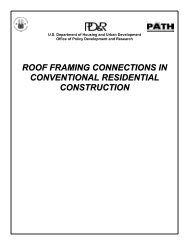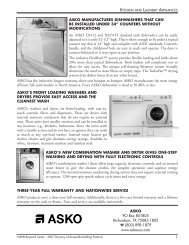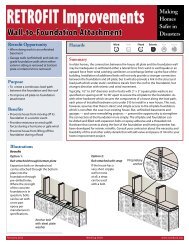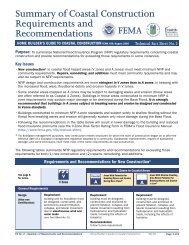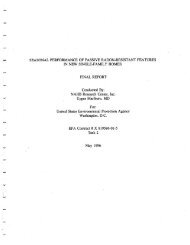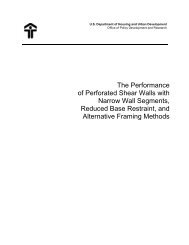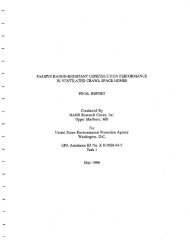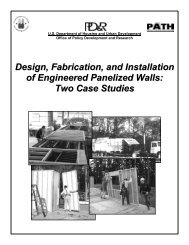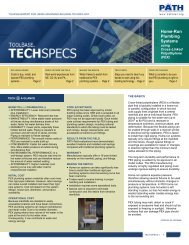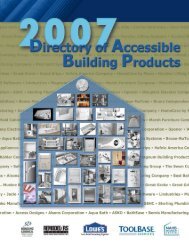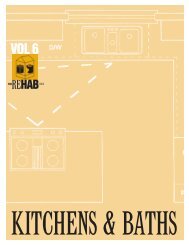The Rehab Guide, Volume 2: Exterior Walls - ToolBase Services
The Rehab Guide, Volume 2: Exterior Walls - ToolBase Services
The Rehab Guide, Volume 2: Exterior Walls - ToolBase Services
Create successful ePaper yourself
Turn your PDF publications into a flip-book with our unique Google optimized e-Paper software.
4SHEA THINGESSENTIAL KNOWLEDGE<strong>Exterior</strong> wall sheathing serves a number of functions. It provides rigidity and shear resistance to the mainframing elements; it is part of the barrier system that keeps out the destructive effects of moisture; it providesvarying degrees of insulation; and it can serve as the nail base for exterior siding.Until the mid-1960s, when plywood was introduced, the dominant sheathing material was 1-by-3 -inch and 1-by-4-inch wood boards, typically nailed diagonally to the stud frame. Today the most commonwall sheathing materials are oriented strand board and plywood, which together account for approximately55 percent of the sheathing market, with slightly more plywood sold than OSB (other siding productsare described below). It is important to recognize that APA - <strong>The</strong> Engineered Wood Association (APA)does not differentiate between plywood and oriented strand board (OSB) under its APA Rated Sheathingprogram. OSB prices have dropped by half over the past several years, and in some areas of the countryit is about half the price of comparable plywood. OSB is expected to be the most common sheathing materialby 2002.If the finished siding has been well maintained, the wall sheathing should not have deteriorated.Exceptions to this would be deterioration from moisture trapped behind the finished siding. Moisture entryis due to improperly flashed or caulked joints between the siding and openings such as doors and windows;inadequate or poorly fabricated flashing at the wall/roof juncture; water driven by high winds between sidingmaterial during rain storms; moisture penetration through mortar joints in brick veneer walls; and thelack of, or improperly lapped, moisture retarder such as building paper or housewrap behind the siding.Much of the research into sheathing failure suggests that, particularly in the case of <strong>Exterior</strong> Insulation andFinish Systems (EIFS), it should be assumed that moisture will penetrate the finished siding and that provisionsshould be made to allow the system to be self-draining between the finish material and the sheathingby means of furring strips, drainage channels, plastic matting, or other devices.TECHNIQUES, MATERIALS, TOOLS1. REPAIR EXISTING WALL SHEATHING.<strong>The</strong> specific sheathing repair will depend on the location and extent of damage and the type of sheathingencountered. <strong>The</strong>re is very little possibility of consolidating existing sheathing material. Replacement isnecessary if the material is unsound and can no longer function as intended. Replacement of sheathingwill require removal and replacement of siding as well.ADVANTAGES: Localized repairs of sheathing are cost-effective if the damage is limited.DISADVANTAGES: Localized repairs will only mask the problems if they are widespread and result in apatchwork of new siding. If the problems are widespread the affected sheathing should be replaced in itsentirety and new siding installed.2. REPLACE EXISTING SHEATHING WITH ORIENTED STRAND BOARD.Introduced in the early 1980s, OSB (made with rectangular-shaped wood strands cross-oriented in layersfor better structural performance) has replaced particleboard, “flakeboard,” “chipboard,” and “waferboard”as the most popular alternative to plywood sheathing. OSB utilizes a variety of fast-growing woodspecies, including aspen, southern yellow pine, poplar, birch, and mixed hardwoods, with waterproofphenolic resin or polyisocyanate binders. Available in varying thicknesses, it typically comes in 4-by-8-footsheets, but can also be custom ordered in lengths up to 24 feet and in widths up to 12 feet.ADVANTAGES: Excellent shear resistance, dimensional stability, and bond durability under normal conditions.28



